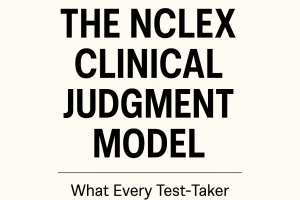PEDIATRIC ONCOLOGY: COMMON CANCERS AND NURSING PRIORITIES FOR NCLEX

Pediatric oncology is a specialized field dedicated to diagnosing and treating cancers in children. While childhood cancer is relatively rare, it remains a leading cause of disease-related death among children worldwide. This blog aims to shed light on the most common pediatric cancers, outline essential nursing priorities for the NCLEX exam, and provide practice questions to enhance understanding.
Common Pediatric Cancers
1. Leukemias: These cancers originate in the bone marrow and blood, with Acute Lymphoblastic Leukemia (ALL) being the most prevalent in children. Symptoms often include fatigue, frequent infections, and easy bruising or bleeding.
2. Brain and Central Nervous System (CNS) Tumors: These tumors can affect various parts of the brain and spinal cord. Common signs are headaches, nausea, balance issues, and changes in behavior or cognitive abilities.
3. Lymphomas: Cancers that begin in the lymphatic system, including Hodgkin and Non-Hodgkin Lymphoma. Symptoms may involve swollen lymph nodes, fever, weight loss, and night sweats.
4. Neuroblastoma: A cancer arising from immature nerve cells, typically affecting infants and young children. It often manifests as an abdominal mass, bone pain, or fatigue.
5. Wilms Tumor: A kidney cancer primarily found in children aged 3 to 4 years. It usually presents as a painless abdominal mass, sometimes accompanied by fever or blood in the urine.
Nursing Priorities for Pediatric Oncology Patients
1. Infection Control: Due to immunosuppression from cancer treatments, children are at heightened risk for infections. Nurses must implement strict hand hygiene, monitor for signs of infection, and educate families on infection prevention.
2. Pain Management: Effective pain control is crucial. This involves regular pain assessments and administering appropriate analgesics, considering both pharmacologic and non-pharmacologic interventions.
3. Nutritional Support: Cancer and its treatments can affect appetite and nutrition. Nurses should assess dietary intake, collaborate with dietitians, and encourage nutrient-rich foods to support growth and recovery.
4. Emotional Support: A cancer diagnosis is emotionally taxing for both the child and their family. Providing psychological support, facilitating support groups, and offering counseling services are essential components of holistic care.
5. Education and Discharge Planning: Families require comprehensive education about the disease, treatment plans, potential side effects, and home care strategies. Clear communication ensures families are well-prepared to manage care at home.
NCLEX-Style Practice Questions
1. Question: A 5-year-old diagnosed with Acute Lymphoblastic Leukemia is receiving chemotherapy. Which nursing intervention is most important?
• A) Encourage a high-protein diet.
• B) Monitor the child for signs of infection.
• C) Allow the child to play outdoors.
• D) Provide age-appropriate toys.
Answer: B) Monitor the child for signs of infection.
Rationale: Chemotherapy suppresses the immune system, increasing infection risk. Vigilant monitoring is essential to detect and treat infections promptly.
2. Question: A child with a brain tumor is exhibiting increased intracranial pressure (ICP). Which symptom is most indicative of this condition?
• A) Bradycardia
• B) Hypertension
• C) Projectile vomiting
• D) Tachypnea
Answer: C) Projectile vomiting
Rationale: Projectile vomiting, especially in the morning, is a classic sign of increased ICP in pediatric patients.
3. Question: When caring for a child with neutropenia following chemotherapy, which action should the nurse take?
• A) Administer live vaccines as scheduled.
• B) Place the child in a private room.
• C) Encourage fresh flowers in the room.
• D) Allow raw fruits and vegetables in the diet.
Answer: B) Place the child in a private room.
Rationale: A private room reduces exposure to potential infections, which is crucial for immunocompromised patients.
4. Question: The parents of a child with Wilms Tumor ask about activities for their child. What is the nurse’s best response?
• A) “Encourage your child to participate in contact sports.”
• B) “Avoid any activities that could cause abdominal injury.”
• C) “Swimming is not recommended for your child.”
• D) “Your child can resume normal activities without restrictions.”
Answer: B) “Avoid any activities that could cause abdominal injury.”
Rationale: Children with Wilms Tumor should avoid activities that might result in abdominal trauma to prevent injury to the tumor site.
Understanding the common types of pediatric cancers and the associated nursing priorities is vital for providing comprehensive care. For those preparing for the NCLEX exam, focusing on these areas will enhance both knowledge and confidence in managing pediatric oncology patients.






